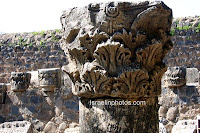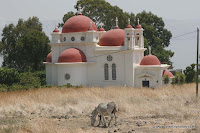Kfar Nahum (Nahum's village), Nahum being a prophet.
An ancient fishing town on the northwestern shore of the Sea of Galilee uninhabited since the eight century.
It has been established that settlement on the site began in the second century BC. It was a small unfortified town that did not take part in the first and second wars against the Romans, and remained peaceful and unscathed.
Jesus settled there after he left Nazareth and it did not offer any unique advantages that could not be found in the other lakeside towns. He probably chose it because his first converts, the fisherman Peter and Andrew, lived there (Mark 1:21,29)
He preached at the synagogue of Capernaum and here he healed various people: a man possessed by the devil, Simon's mother in-law, a paralytic, and eventually many of the sick and possessed of the town (Mark 1:21-34). It was also in Capernaum that Jesus raised from the dead the daughter of Jairus, an official of the synagogue (Mark5:21-43). Some of Jesus' converts either lived or settled there, because a continuing Christian presence is attested both archeologically and textually. In rabbinic texts from the fourth century we read that there was a considerable tension between the two communities. Both communities had their religious centres, as Egeria noted on her visit there between 381 and 384: "In Capernaum the house of the prince of the apostles has been made into a church, with its originally walls standing".
There also is the synagogue where the Lord cured a man possessed by the devil. The way in is up many stairs, and it is made of decorated stone.
The synagogue was the most impressive structure in the town, made of white limestone brought from a distant quarry to this region of black basalt. The excavators claim that the building was built in several pre-planned stages over a century beginning in the middle of the fourth century.
Entrance to the synagogue was from the south, the direction of Jerusalem. The lintels’ ornamentation includes geometric designs, plants, and animals; a stone eagle and cupids holding wreaths, later destroyed by iconoclasts, hovered over the entrance. Pillars in “U” formation supported the second floor and the roof. The inside walls were plastered and the floor was of stone. The congregation sat along the walls facing the center, where the Torah was probably read. A large room and courtyard, possibly the house of study, stood adjacent and to the east of the synagogue.
The ruins in the garden include a Corinthian capital adorned with symbols of a menorah and a shofar, architectural fragments containing the Star of David (was not a Jewish symbol 2000 years ago). Here the six-pointed star appears next to the five-pointed star. Look for the representations of some of the seven species with which the Land of Israel is blessed (wheat, barley, grapes, pomegranates, datepalms, figs, and olives Deuteronomy 8:8). One stone shows a pair of pillars similar in design to those found at Hamat Tiberias, a motif also found in Roman temples. The Aramaic inscription refers to a donor. The next stone depicts a temple on wheels, perhaps representing the tabernacle that travelled with the Jews in the desert.
The House of Peter is another dwelling of importance, built in the first century BC. This was a common, poor residence with several rooms grouped around an irregular courtyard. One of the rooms had painted plaster on the wall. In the second stage, in the fourth century, this room became the centre of the building that was surrounded by a wall and thus secluded from the town. This may have been the church seen by Egeria. In the fifth century this building was levelled and an octagonal church built on the site. The church had a mosaic floor, including a peacock centerpiece. Although there is nothing in the early house to identify its owner, its development into a church indicates a tradition connecting it with Peter and with the activities of Jesus in Capernaum.
The land was purchased in 1894 by Franciscan fathers who built a monastry next to the synagogue.

























